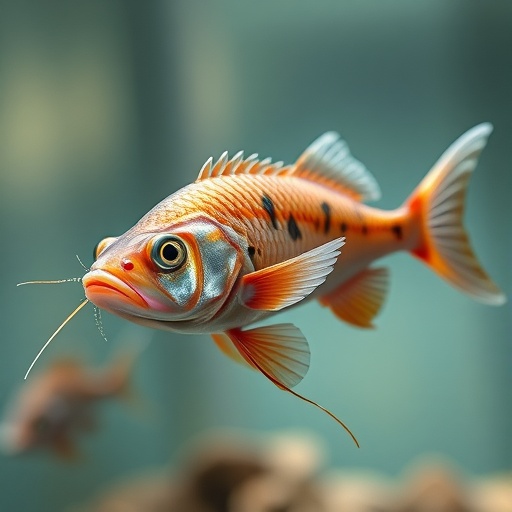In an intriguing study published in 2025, researchers have explored the effects of three pharmacological compounds—Gabapentin, Valsartan, and Codeine—on the hemato-biochemical and histological biomarkers in male catfish, specifically the species Clarias gariepinus, a notable fish in aquaculture and ecological studies. This investigation aims to shed light on the broader impacts of pharmaceutical contaminants in aquatic environments, drawing attention to their implications for fish health and aquatic ecosystems.
The cornerstone of this research lies in the growing concern surrounding water pollution, particularly the presence of pharmaceutical products that often find their way into natural water sources. Human medications can enter aquatic systems through various means including pharmaceutical manufacturing, improper disposal, and runoff from agricultural practices. The result is often a cocktail of drugs that can profoundly affect aquatic biodiversity, ecosystem dynamics, and the health of fish populations.
Gabapentin, primarily used in humans for treating seizures and neuropathic pain, has garnered increasing attention for its effects on non-target organisms within aquatic systems. Its mode of action, primarily involving the modulation of neurotransmitter release, raises questions about how such pharmaceuticals may disrupt the physiological processes in fish. Notably, the researchers focused on various hematological parameters to understand how exposure to Gabapentin could affect the overall health and behavior of the male catfish.
In addition to Gabapentin, Valsartan—a medication used to treat high blood pressure—was included in the study. Valsartan works by blocking the effects of specific hormones involved in blood pressure regulation, but the unintended consequence is that it may influence the endocrine systems of fish when present in their environment. The researchers measured several biochemical markers to ascertain the drug’s impact on metabolic functions and overall vitality in catfish.
Codeine, a well-known opiate, also featured prominently in this research. Its potential impacts on aquatic organisms have been understudied, despite its prevalence as a common prescription medication. Codeine’s analgesic properties and its ability to influence neurotransmission make it particularly interesting in the context of aquatic toxicology. The researchers sought to measure changes in histological markers indicating any detrimental effects on fish tissue structure resulting from codeine exposure.
A significant aspect of this research is the methodological rigor applied during the experiments. The team employed controlled conditions, careful dosing, and statistical analyses to derive meaningful results from their experiments. Such robust approaches ensure that the findings hold weight in real-world contexts, where fish populations are often exposed to multiple chemical agents simultaneously.
One of the key findings of the investigation was a notable alteration in the hematological parameters of male catfish exposed to these pharmaceuticals. Researchers observed significant variations in red and white blood cell counts, which serve as vital indicators of fish health. Such changes could imply compromised immune systems or overall stress in the fish populations, raising alarms about the ecological ramifications of pharmaceutical exposure.
Moreover, the biochemical markers assessed in this study revealed critical insights into the metabolic health of the male catfish. Altered enzyme levels signify shifts in organ function, particularly in the liver and kidneys, which handle detoxification and metabolic waste processing. By elucidating these changes, the research draws a comprehensive picture of how pharmaceuticals fundamentally disrupt fish physiology.
The histological analyses accompanied by these findings provided further evidence of the adverse impacts of pharmaceutical contaminants. Microscopic evaluations of tissue samples highlighted degenerative changes that could impede normal biological functions. This aspect of the research underscores the need for more extensive monitoring of pharmaceutical residues in aquatic habitats.
Beyond the specific implications for Clarias gariepinus, the study invites broader discourse on the ecological consequences of pharmaceutical pollution. As fish play critical roles in aquatic ecosystems, their health directly affects food webs and biodiversity. The potential for drug accumulation within these organisms poses risks not only to aquatic life but also to humans who consume these fish.
The researchers advocate for a systems-level approach, emphasizing that mitigation strategies should account for the synergistic effects of mixed pharmaceuticals on aquatic organisms. Future efforts in environmental policy and management must address the sources of pharmaceutical pollutants, looking at both reduction and improved management practices within the healthcare and agricultural sectors.
This research also highlights the critical gap in existing regulations regarding pharmaceutical contaminants in water bodies. Current guidelines may need to be re-evaluated to incorporate findings from studies such as this, which reveal the extensive and often unregulated presence of medications in aquatic systems. Proposals for stricter guidelines and treatment technologies for wastewater could lead to improved outcomes for both the environment and public health.
As awareness grows about the complexities of aquatic toxicology, it is imperative for scientists, policymakers, and the public to collaborate on solutions. Integrating research findings into legislative frameworks can catalyze significant changes in how society approaches the issue of pharmaceutical pollution. The health of our waterways is paramount, serving as a reflection of our values and priorities concerning environmental stewardship.
In summation, the study led by El-Sayed et al. not only addresses a pressing environmental concern but also calls all stakeholders to action. By disseminating this knowledge and driving forward discussions on policy and practice, we can begin to formulate a multi-faceted strategy that recognizes the intrinsic link between human health, aquatic life, and environmental integrity.
The outcomes of this research could serve as a pivotal stepping stone toward revealing the undercurrents of pharmaceutical impacts in aquatic environments. As further studies unfold, a clearer picture is expected to emerge regarding the cumulative effects of these agents on biodiversity and ecological balance, paving the way for informed decision-making and environmental preservation strategies.
Subject of Research: The effects of Gabapentin, Valsartan, and Codeine on male catfish (Clarias gariepinus).
Article Title: Effects of Gabapentin, Valsartan, and Codeine on hemato-biochemical and histological biomarkers of male catfish (Clarias gariepinus).
Article References:
El-Sayed, A.A.A., Abdel-Samei, W.M., Soliman, H.A.M. et al. Effects of Gabapentin, Valsartan, and Codeine on hemato-biochemical and histological biomarkers of male catfish (Clarias gariepinus).
Environ Sci Pollut Res (2025). https://doi.org/10.1007/s11356-025-36797-3
Image Credits: AI Generated
DOI: 10.1007/s11356-025-36797-3
Keywords: Pharmaceuticals, Aquatic Toxicology, Catfish, Environmental Impact, Hematological Parameters, Biochemical Markers, Histological Analysis.




